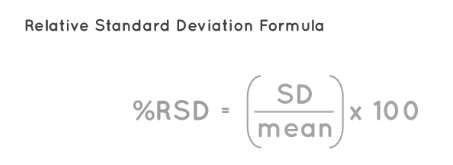
Relative Standard Deviation Formula: The Relative Standard Deviation (RSD) serves as a specialized form of Standard Deviation (SD). This formula offers insight into the relationship between the standard deviation and the mean within a dataset, determining whether the standard deviation is relatively small or large compared to the mean. For Example, if the standard deviation measures 0.1 and the mean is 3.5, the RSD for this dataset would be calculated as 100 x 0.1 / |3.5|, resulting in 2.86%.
This 2.86% RSD, indicating that the standard deviation is only 2.86% of the mean (3.5), reflects a very small deviation. Essentially, this suggests that the data points are closely clustered around the mean. Conversely, a larger RSD percentage, such as 56%, would imply a more considerable spread within the data. Understanding the details of the relative standard deviation formula provides a deeper comprehension of these relationships.
Relative Standard Deviation Formula
The relative standard deviation offers insights into the accuracy of data within an experiment. Higher precision in the data leads to a smaller RSD. Typically, RSD is expressed alongside the mean using a plus/minus symbol, for example, 3.5 ± 2.86%. The formula for relative standard deviation is:
Relative standard deviation = 100 × s / |x̄|
Where:
s = sample standard deviation
x̄ = sample mean
Relative Standard Deviation Formula

Let's explore how to apply the relative standard deviation formula in the forthcoming solved examples section.
Relative Standard Deviation Formula Solved Examples
Example 1: Here's the data of scores obtained by 4 students in a math examination: 60, 98, 65, 85. Use the relative standard deviation formula to find the RSD.
Solution:
Mean calculation:
¯x = (60 + 98 + 65 + 85) / 4 = 307 / 4 = 76.75
Standard deviation calculation:
s = √[Σ(x - ¯x)² / (n - 1)]
s = √[(938) / 3]
s ≈ 17.66
Relative standard deviation = (s × 100) / ¯x
RSD = (17.66 × 100) / 76.75
RSD ≈ 22.98%
Answer: The RSD is approximately 22.98%.
Example 2: 4 measurements collected as a sample: 51, 55, 49, and 52. Calculate the relative standard deviation.
Solution:
Mean calculation:
¯x = (51 + 55 + 49 + 52) / 4 = 207 / 4 = 51.75
Standard deviation calculation:
S = √[((51 - 51.75)² + (55 - 51.75)² + (49 - 51.75)² + (52 - 51.75)²) / 3]
S = √[(0.5625 + 12.5625 + 7.5625 + 0.0625) / 3]
S = √[20.75 / 3]
S ≈ 2.5
Relative standard deviation, RSD = (100 × S) / ¯x
RSD = (100 × 2.5) / 51.75 ≈ 4.83%
This can be expressed as 51.75 ± 2.5 or 51.75 ± 4.83%.
Answer: The standard deviation is 51.75 ± 4.83%.
Example 3: Suppose we have a dataset of values: 12, 15, 18, 21, 24, and 27. Compute the relative standard deviation for this data.
Solution:
Mean calculation:
¯x = (12 + 15 + 18 + 21 + 24 + 27) / 6 = 117 / 6 = 19.5
Standard deviation calculation:
First, find the differences between each data point and the mean:
(12 - 19.5)² = 56.25
(15 - 19.5)² = 20.25
(18 - 19.5)² = 2.25
(21 - 19.5)² = 2.25
(24 - 19.5)² = 20.25
(27 - 19.5)² = 56.25
Calculate the sum of the squared differences: 56.25 + 20.25 + 2.25 + 2.25 + 20.25 + 56.25 = 157.5
Standard deviation formula:
s = √[Σ(x - ¯x)² / (n - 1)]
s = √[157.5 / 5] ≈ √31.5 ≈ 5.61
Relative standard deviation calculation:
RSD = (100 × s) / ¯x
RSD = (100 × 5.61) / 19.5 ≈ 28.77%
Answer: The RSD for the dataset is approximately 28.77%.
Example 4: Consider a set of data: 5, 10, 15, 20, 25, 30, 35. Determine the relative standard deviation for this dataset.
Solution:
Mean calculation:
¯x = (5 + 10 + 15 + 20 + 25 + 30 + 35) / 7 = 140 / 7 = 20
Standard deviation calculation:
First, find the differences between each data point and the mean:
(5 - 20)² = 225
(10 - 20)² = 100
(15 - 20)² = 25
(20 - 20)² = 0
(25 - 20)² = 25
(30 - 20)² = 100
(35 - 20)² = 225
Sum of squared differences: 700
Standard deviation formula:
s = √[Σ(x - ¯x)² / (n - 1)]
s = √[700 / 6] ≈ √116.67 ≈ 10.8
Relative standard deviation calculation:
RSD = (100 × s) / ¯x
RSD = (100 × 10.8) / 20 = 54%
Answer: The RSD for the dataset is 54%.
Explore Now Online Course of Class 9 Neev Fastrack 2024 and Class 10 Udaan Fastrack 2024 to enhance your Maths knowledge. and build a strong foundation.
| Related Links | |
| Hexagonal Pyramid Formula | Hypothesis Testing Formula |
| Interquartile Range Formula | Inverse Variation Formula |
Relative Standard Deviation Formula FAQs
What is the Relative Standard Deviation (RSD)?
What does RSD indicate about a dataset?
What is the formula for RSD?
How is RSD useful in data analysis?










